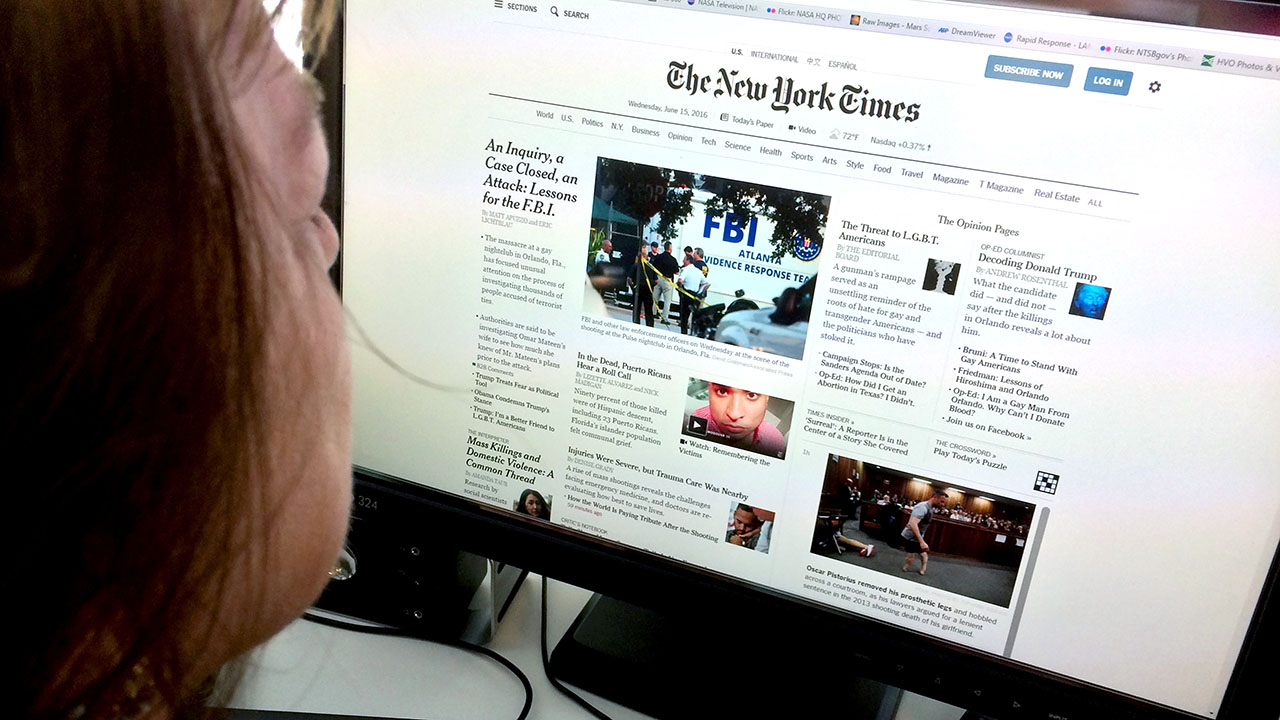The Beginner’s Guide to stnews.live Content
Wiki Article
The Effect of Social Media Site on the Means We Eat News Online
Social media site has actually basically changed news usage. It supplies immediate access to info, usually overshadowing typical media outlets. Nonetheless, this fast dissemination features obstacles. Individuals encounter the risk of encountering misinformation and becoming trapped in echo chambers. The algorithms driving personalized material can cover diverse viewpoints. As these dynamics progress, comprehending their implications comes to be crucial for educated involvement in public discourse. What strategies might help browse this complicated landscape?The Development of News Intake in the Digital Age
As innovation progressed, the means people consumed news changed significantly in the electronic age (stnews.live). Conventional newspapers and broadcast media started to decrease as the web became a main resource of details. On the internet systems provided instant access to news write-ups, videos, and podcasts, enabling customers to stay informed at any kind of time. The comfort of smart phones even more accelerated this change, enabling users to get updates on the goFurthermore, the rise of news collectors and internet sites assisted in the consumption of diverse point of views, encouraging individuals to tailor their news consumption based upon personal rate of interests. This evolution likewise prompted wire service to adjust their strategies, concentrating on electronic content and appealing readers through multimedia layouts. As a result, the typical obstacles of time and area in news delivery diminished, causing a more immediate and personalized news experience for audiences worldwide.
The Role of Social Media Platforms in News Distribution
Social media platforms have actually changed news circulation by supplying instant access to information. Their algorithm-driven material curation frequently focuses on engagement over accuracy, resulting in substantial credibility difficulties (stnews.live). As individuals navigate this landscape, the ramifications for news intake and public discussion ended up being increasingly complicatedImmediate News Gain Access To
Conventional news outlets have long been the main source of details, the increase of social media platforms has drastically transformed how news is accessed and consumed. Instant news gain access to has become a characteristic of the electronic age, making it possible for individuals to receive updates in actual time. Systems such as Twitter, Facebook, and Instagram allow news to spread quickly, commonly surpassing conventional media in speed and reach. Users can share tales, discuss events, and engage with reporters, developing a vibrant communication in between the audience and news web content. This immediacy cultivates a culture of necessity, motivating customers to look for information swiftly. The assumption for prompt news has actually improved journalistic techniques, compelling news organizations to adjust their approaches to fulfill the demands of a busy digital setting.Algorithm-Driven Web content
While individuals actively engage with material on social networks, the algorithms that control these platforms play a crucial role in establishing which news stories obtain presence. These algorithms examine individual behavior, choices, and involvement metrics to curate tailored news feeds. Consequently, certain tales may be magnified while others remain rare, commonly prioritizing mind-blowing or trending subjects over substantive coverage. This discerning direct exposure shapes customers' assumptions of existing events and affects public discourse. In addition, the dependence on algorithm-driven web content can create echo chambers, where individuals are generally exposed to perspectives that straighten with their own ideas. The characteristics of news circulation on social media systems substantially affect just how people take in and translate information in the digital age.Integrity Difficulties
As users increasingly turn to social networks for news, the reliability of information run into on these platforms ends up being a pushing problem. The decentralized nature of social media sites permits any individual to release web content, typically obscuring the lines in between dependable journalism and false information. Algorithms prioritize interaction over accuracy, resulting in the extensive dissemination of marvelous or deceptive stories. This setting postures significant obstacles for individuals attempting to discern reliable resources. Social media platforms, while endeavoring to combat misinformation with fact-checking and material moderation, face criticism for inconsistencies and prejudices in their techniques. Eventually, the responsibility lies with individuals to seriously evaluate the news they consume, as the rapid spread of info commonly outpaces confirmation initiatives by systems.The Rise of Resident Journalism and User-Generated Web Content
The surge of resident journalism has actually equipped daily people to share news and viewpoints, commonly providing insights that typical media may overlook. Nevertheless, this change also presents considerable obstacles, particularly the spread of false information that can arise from unverified material. As user-generated material comes to be much more widespread, the equilibrium between authentic voices and precision in coverage continues to be a crucial concern.Empowering Daily Voices

Difficulties of False information
While the surge of resident journalism has opened avenues for diverse voices in the media landscape, it has additionally introduced substantial difficulties connected to misinformation. The convenience of sharing details with social media sites platforms allows people to share news rapidly, but this fast spread commonly comes at the cost of precision. User-generated web content often does not have the rigorous fact-checking and editorial oversight that standard journalism supplies. As a result, sensationalized or false stories can acquire grip, misdirecting audiences and forming public perception (stnews.live). The mixing of point of view and fact within social media complicates the distinction between reputable details and misinformation. As an outcome, customers have to navigate a significantly complex media environment, requiring essential thinking skills to discern dependable news sources in the middle of the noise
False information and Its Ramifications for Public Discourse
As social media systems significantly dominate the landscape of details circulation, the spreading of false information positions considerable obstacles for public discourse. Misinformation, usually designed to mislead or prompt emotional actions, can distort perceptions of truth and weaken count on credible sources. This sensation leads to polarized perspectives, as people move towards resemble chambers that strengthen their beliefs, additionally entrenching divisions within culture.The effects for public discourse are profound. When people depend on false details, significant discussion decreases, and the autonomous process suffers. Additionally, false information can prompt fear and complication, impacting public wellness, safety, and political stability. Therefore, fostering media literacy ends up being vital, encouraging people to seriously assess information and recognize truth from fiction. Resolving the obstacles postured by misinformation is crucial for protecting the honesty of public discussion and making certain a knowledgeable people capable of taking part in constructive conversations.
The Influence of Formulas on News Visibility
Provided the central duty of formulas in establishing material exposure, their influence on news intake is profound. These algorithms, made use of by social media platforms, prioritize certain kinds of web content based on customer interaction and choices. As a result, newspaper article that straighten with popular patterns or audience passions are more probable to be displayed prominently, while much less thrilling tales may be neglected. This creates a setting where individuals are exposed largely to i was reading this information that reinforces their point of views, possibly causing resemble chambers.The consistent evolution of formulas suggests that news companies should adjust their techniques to line up with these transforming specifications, commonly prioritizing clickbait or emotionally charged headings. Consequently, the honesty of news coverage can be jeopardized, as crucial tales may not receive the exposure they are worthy of. The algorithmic shaping of news exposure as a result plays an important duty in affecting public perception and understanding of present occasions.
The Change Towards Visual Narration in News Media
Increasingly, news media is welcoming aesthetic narration as an effective tool to involve target markets. This technique leverages pictures, video clips, infographics, and interactive components to convey information better than standard text-based layouts. As interest spans shorten, visuals offer a fast, impactful method to connect complicated stories and grab visitors' interest.Systems like Instagram and TikTok have further increased this pattern, engaging news organizations to adapt their content methods to fit these visually-driven settings. By integrating engaging visuals, news electrical outlets can improve psychological connections and foster higher understanding of topical concerns.
Aesthetic storytelling enables for even more diverse narratives, showcasing several point of views through dynamic discussions. As target markets increasingly consume news through mobile phones, the shift towards visuals not only deals with user preferences but likewise helps to damage down barriers to info gain access to. Eventually, this development mirrors a broader transformation in just how news is created and consumed in the electronic age.
Future Fads: Browsing the Transforming Landscape of News Usage
While the digital landscape continues to advance, news intake is poised for substantial change driven by arising modern technologies and transforming audience actions. As fabricated intelligence and artificial intelligence advance, customized news feeds will certainly become extra widespread, enabling customers to obtain content customized to their rate of interests. This personalization can bring about higher engagement but likewise raise concerns about resemble chambers and misinformation.The surge of voice-activated tools and clever speakers will certainly influence exactly how news is provided, changing the focus from aesthetic to acoustic formats. This fad may urge news companies to embrace more concise and interesting audio material.

Often Asked Questions
How Do Social Network Interactions Affect News Trustworthiness?
Social network interactions can substantially affect perceptions of news reliability. Interaction metrics, such as sort and shares, usually form audience trust fund, with popular Discover More posts obtaining viewed authenticity, despite the precision or integrity of the info presented.What Function Do Influencers Play in Shaping News Narratives?
Influencers considerably form news narratives by leveraging their platforms to enhance specific tales, commonly tailoring content to their target market. This can result in prejudiced point of views, impacting public assumption and focusing on sensationalism over valid reporting.Just How Can Users Identify Reliable News Sources on Social Media?
Users can determine trusted news resources on social media look at these guys sites by inspecting the resource's credibility, confirming facts with numerous electrical outlets, assessing the professionalism and reliability of the material, and identifying possible biases in reporting to ensure precise info.What Impact Does Social Media Site Have on Traditional Journalism Jobs?
Social media site significantly affects conventional journalism tasks by altering earnings models, minimizing need for print media, and promoting competition from resident reporters. As a result, many experts encounter job insecurity and need to adapt to quickly altering media landscapes.How Do Different Demographics Consume News on Social Media?
Various demographics exhibit diverse choices for news intake on social networks. More youthful audiences prefer platforms like TikTok and Instagram for fast updates, while older individuals often tend to like Facebook and Twitter for more thorough discussions and write-ups.Report this wiki page